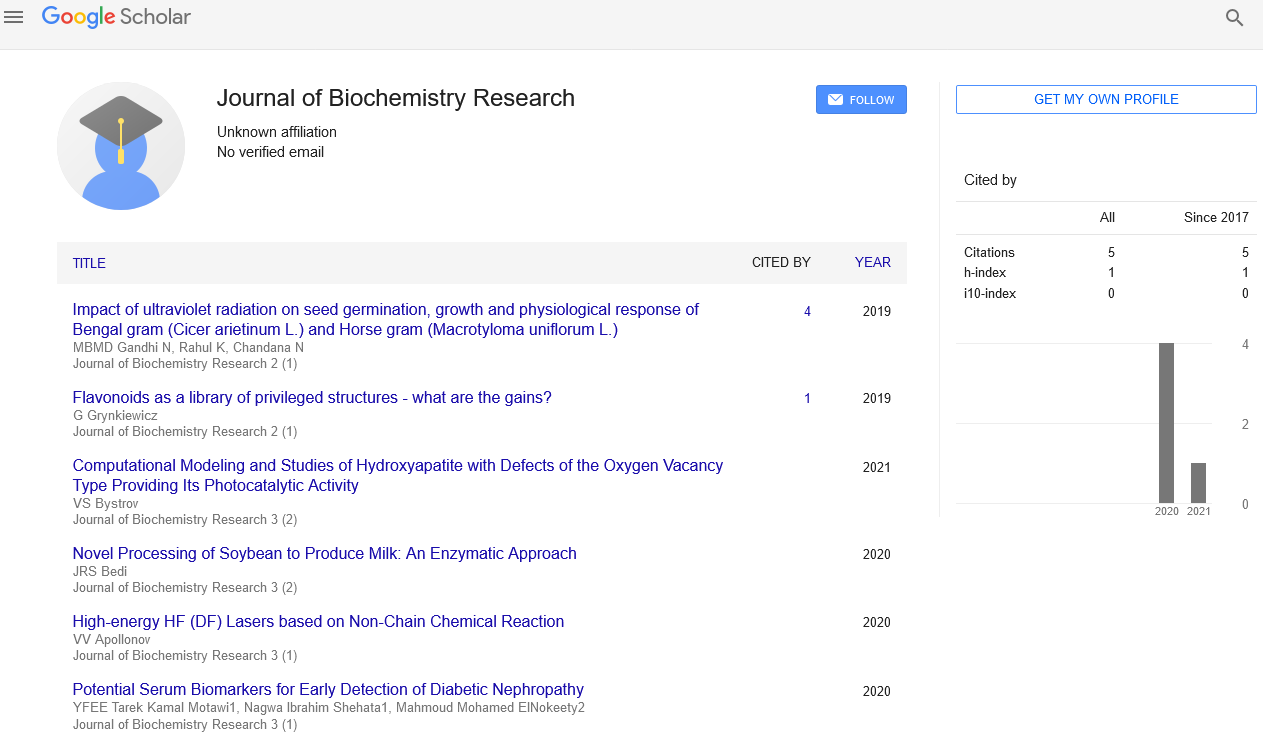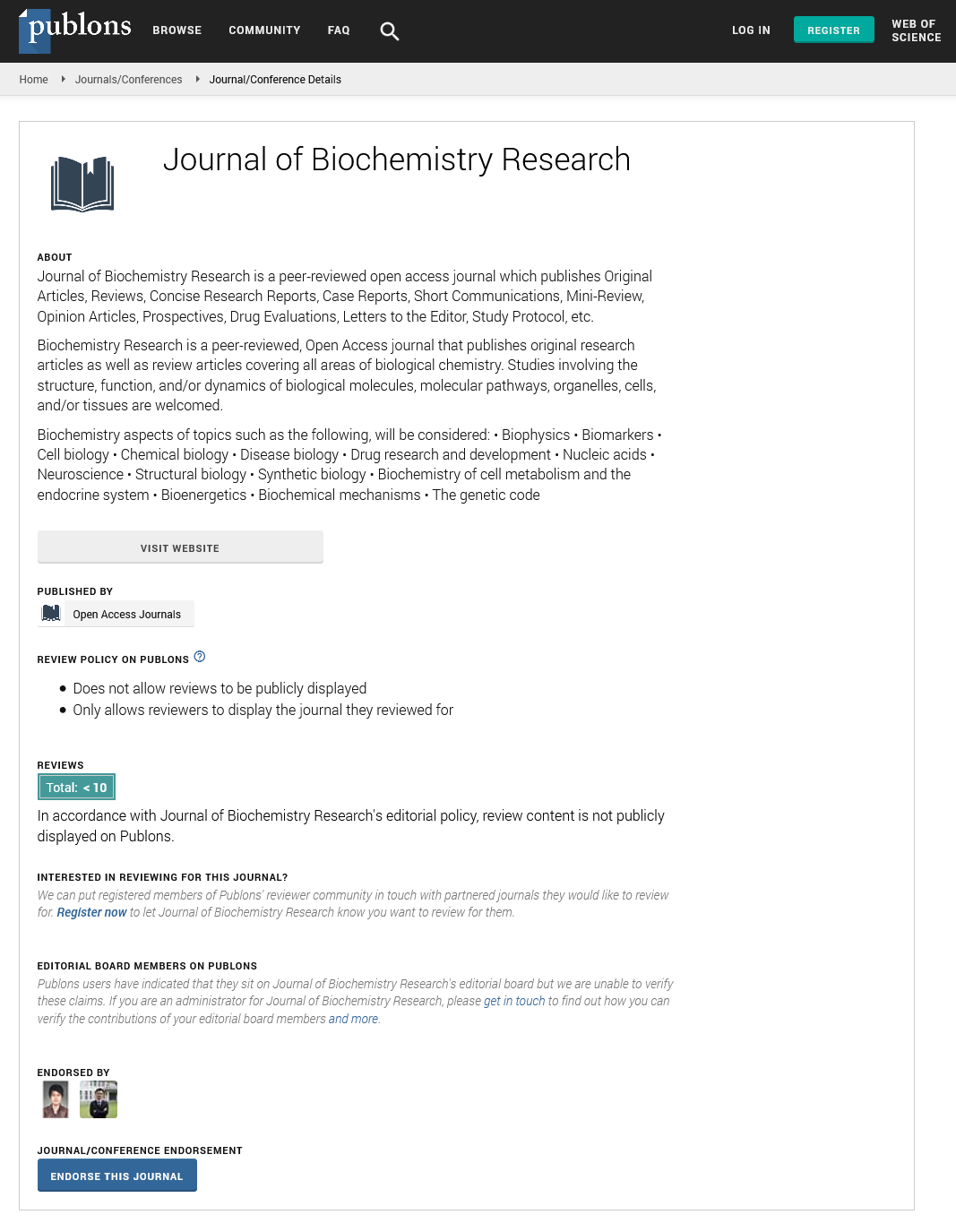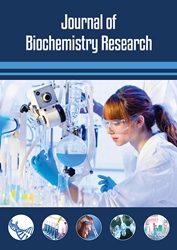Editorial - Journal of Biochemistry Research (2023) Volume 6, Issue 3
Exploring the Industrial Applications of Biochemistry in Food and Chemical Sectors
Caifang Wang*
Department of Medical Science and biochemistry, University of China Science and technology
Department of Medical Science and biochemistry, University of China Science and technology
E-mail: caifangw@gmail.com
Received: 02-06-2023, Manuscript No. oabr-23-101505; Editor assigned: 05-06-2023, Pre QC No. oabr-23- 101505; Reviewed: 19-06-2023, QC No. oabr-23-101505; Revised: 22-06- 2023, Manuscript No. oabr-23-101505 (R); Published: 29-06-2023; DOI: 10.37532/oabr.2023.6(3).61-63
Abstract
Biochemistry has emerged as a critical field with diverse applications in various industries, including food and chemicals. This article explores the industrial applications of biochemistry in these sectors, highlighting its contributions to food production, processing, and quality enhancement, as well as its role in developing innovative chemicals and promoting sustainability. By employing enzymatic technologies, fermentation processes, and nutrient enhancement techniques, biochemistry revolutionizes the food industry, improving production efficiency and nutritional value. In the chemical industry, biochemistry enables biocatalysis, the development of biopolymers, and bioremediation, fostering sustainable and environmentally friendly practices. Additionally, biochemistry plays a crucial role in crop improvement, pesticide development, and soil health management in the agricultural sector. As biochemistry continues to advance, it will pave the way for further innovations, revolutionizing industries and promoting a healthier and more sustainable future.
Keywords
Biochemistry • Industrial applications • Food industry • Chemical industry • Enzymatic technologies • Fermentation • Nutrient enhancement
Introduction
Biochemistry, the study of chemical processes and substances within living organisms, plays a crucial role in various industrial sectors. In this article, we will delve into the numerous applications of biochemistry, focusing specifically on its significance in the food and chemical industries. From enhancing food production to developing innovative chemicals, biochemistry continues to revolutionize these sectors, fostering advancements in sustainability, safety, and overall product quality [1]. Biochemistry, a branch of science that investigates the chemical processes and substances within living organisms, has significant implications in various industrial sectors. Two key areas where biochemistry plays a vital role are the food industry and the chemical industry [2]. In the realm of food, biochemistry contributes to enhancing production processes, improving product quality, and ensuring the nutritional value of food products [3]. In the chemical industry, biochemistry enables the development of innovative and sustainable approaches for the synthesis of chemicals, the production of biodegradable materials, and the remediation of environmental pollutants [4]. Understanding the industrial applications of biochemistry in these sectors is crucial for driving advancements in sustainability, safety, and overall product effectiveness [5].
Materials and Methods
When studying the industrial applications of biochemistry in the food and chemical sectors, several methodologies and techniques are employed to achieve specific goals [6]. This section provides an overview of some commonly used methods and approaches in these industries [7].
Enzyme technology: Enzymes play a crucial role in various processes in the food industry. To utilize enzyme technology effectively, the following methods are employed:
a. Enzyme production: Enzymes can be produced through microbial fermentation or genetically modified organisms (GMOs)[8]. Fermentation involves the growth of microorganisms in
a suitable culture medium, followed by the extraction and purification of the target enzyme [9]. In the case of GMOs, genetic engineering techniques are used to introduce specific genes into organisms to produce enzymes of interest [10].
b. Enzyme characterization: Once enzymes are produced, their properties need to be characterized. This involves determining factors such as optimal temperature and pH range, substrate specificity, stability, and kinetics. Various biochemical assays and spectrophotometric methods are employed to measure enzyme activity and characterize its properties.
c. Enzyme application: Enzymes are applied in food processing to enhance production and improve product quality. The application of enzymes depends on the specific process involved, such as baking, brewing, dairy production, or meat processing. The appropriate dosage and conditions for enzyme application are determined through experimentation and optimization.
Fermentation processes: Fermentation is a biochemical process that utilizes microorganisms to convert organic compounds into desired products. The following methods are used in fermentation processes.
a. Microbial strain selection: Choosing the right microbial strain is crucial for achieving the desired product during fermentation. Strain selection involves screening and identifying microorganisms with the desired metabolic capabilities. This can be done through isolation from natural sources or genetic engineering approaches.
b. Culture medium optimization: The composition of the culture medium significantly affects fermentation outcomes. Various ingredients such as carbon sources, nitrogen sources, vitamins, and minerals need to be optimized to provide an optimal environment for the growth and metabolic activity of the microorganisms.
c. Fermentation conditions: Fermentation conditions, including temperature, pH, oxygen availability, and agitation, need to be controlled to maximize product yield and quality. Monitoring and controlling these parameters during fermentation are critical for achieving the desired outcomes.
Biocatalysis: Biocatalysis involves the use of enzymes and microorganisms to catalyze chemical reactions. The following methods are employed in biocatalysis:
a. Enzyme immobilization: Immobilization techniques are used to immobilize enzymes on solid supports or within matrices to enhance their stability and reusability. Immobilized enzymes can be used in continuous flow systems, allowing for efficient conversion of substrates.
b. Substrate selection and preparation: Substrate selection is crucial for biocatalysis, as different enzymes have specific substrate preferences. Substrate preparation may involve chemical modification or enzymatic hydrolysis to generate the desired starting material for the biocatalytic reaction.
c. Reaction optimization: Optimization of reaction conditions, such as temperature, pH, substrate concentration, and co-factor availability, is essential for achieving high reaction yields and product selectivity. Experimental design methodologies, such as response surface methodology or high-throughput screening, can be used to optimize reaction conditions systematically.
Analytical techniques: Analytical techniques are utilized to monitor and analyze various parameters during food and chemical processes. Common analytical techniques used in biochemistry include Spectrophotometric methods are used to measure enzyme activity, substrate/ product concentrations, and other biochemical parameters. UV-Visible spectrophotometry is often employed to quantify compounds based on their absorption characteristics.
Food industry
Enzyme technology: Biochemistry enables the utilization of enzymes for various purposes in the food industry. Enzymes enhance food production processes such as baking, brewing, cheesemaking, and meat tenderization, improving product quality and reducing production time.
Fermentation: Biochemical processes like fermentation are utilized in the production of a wide range of food products, including bread, yogurt, sauerkraut, and alcoholic beverages. These processes involve the breakdown of complex molecules into simpler compounds through the action of microorganisms, leading to desirable flavor, texture, and preservation.
Nutrient enhancement: Biochemical techniques such as fortification and enrichment are employed to enhance the nutritional value of food. Biochemical analysis helps identify nutrient deficiencies and develop effective strategies to fortify foods with essential vitamins, minerals, and amino acids, combating malnutrition on a global scale.
Chemical industry
Biocatalysis: Biochemistry has opened new avenues in the chemical industry through the use of biocatalysts. Enzymes and microorganisms are utilized to catalyze chemical reactions, resulting in higher yields, selectivity, and environmental friendliness. Biocatalysis enables the synthesis of various chemicals, pharmaceuticals, and biofuels, reducing reliance on traditional, energy-intensive chemical processes.
Biopolymers: Biochemistry facilitates the development of biodegradable and renewable biopolymers, offering a sustainable alternative to conventional plastics. Biomolecules such as starch, cellulose, and proteins are utilized to produce eco-friendly packaging materials, reducing environmental pollution and waste.
Bioremediation: Biochemistry plays a crucial role in addressing environmental challenges by employing biological processes to clean up contaminated sites. Microorganisms are utilized to degrade hazardous chemicals and pollutants, transforming them into less harmful substances. Bioremediation offers a cost-effective and sustainable solution for soil and water cleanup.
Agricultural applications
Crop improvement: Biochemistry aids in crop improvement through genetic engineering and molecular breeding techniques. By understanding the biochemical pathways responsible for plant growth, development, and disease resistance, scientists can enhance crop traits such as yield, nutritional content, and tolerance to biotic and abiotic stresses.
Pesticide development: Biochemical studies help in the development of safer and more effective pesticides. By understanding the biochemical processes in pests, researchers can design targeted pesticides that are specific to the pest species, minimizing the impact on beneficial organisms and the environment.
Soil health: Biochemistry plays a significant role in understanding and improving soil health. Analysis of soil enzymes, microbial activity, and nutrient cycles helps optimize fertilizer use, promote sustainable farming practices, and enhance soil fertility.
Conclusion
Biochemistry plays a vital role in the food and chemical industries, revolutionizing production processes, improving product quality, and fostering sustainability. In the food industry, biochemistry enhances food production, fermentation, and nutrient enrichment. In the chemical industry, biochemistry enables biocatalysis, the development of biopolymers, and bioremediation. These applications contribute to the advancement of sustainable practices, reduction of environmental impact, and the development of safer and more efficient production methods. By harnessing the power of biochemistry, industries can continue to innovate and meet the evolving demands of a global society.
References
- Maglaveras N, Stamkopoulos T, Diamantaras K et al. ECG pattern recognition and classification using non-linear transformations and neural networks: a review. Int J Med Inform. 52,191–208 (1998).
- Acharya UR, Faust O, SreeV et al. Linear and nonlinear analysis of normal and CAD-affected heart rate signals. Comput Methods Programs Bio. 113, 55–68 (2014).
- Brunelli D, Polonelli T, Benini L et al. Ultra-low energy pest detection for smart agriculture. IEEE Sens J. 1-4 (2020).
- Dora, Veronica Della. Infrasecular geographies: Making, unmaking and remaking sacred space. Prog Hum Geogr. 42, 44-71 (2018).
- Fonseca, Frederico Torres. Using ontologies for geographic information integration. Transactions in GIS.6,231-257 (2009).
- Imrie, Rob. Industrial change and local economic fragmentation: The case of Stoke-on-Trent. Geoforum. 22, 433-453 (1991).
- Harrison, Paul. How shall I say it? Relating the nonrelational .Environ Plan A. 39, 590-608 (2007).
- Jackson, Peter. The multiple ontologies of freshness in the UK and Portuguese agri food sectors. Trans Inst Br Geogr. 44, 79-93 (2019).
- Ananthakrishnan R, Ehrlicher A.The forces behind cell movement. Int J Biol Sci.3, 303-317(2007).
- Michie KA, Löwe J.Dynamic filaments of the bacterial cytoskeleton. Annu Rev Biochem.75, 467-492(2006).
Indexed at, Google Scholar, Crossref
Indexed at, Google Scholar, Crossref
Indexed at, Google Scholar, Crossref
Indexed at, Google Scholar, Crossref
Indexed at, Google Scholar, Crossref
Indexed at, Google Scholar, Crossref
Indexed at, Google Scholar, Crossref
Indexed at, Google Scholar, Crossref


